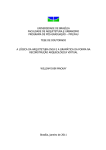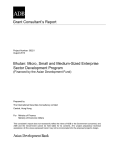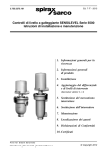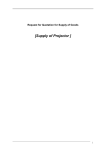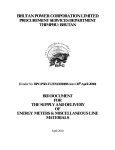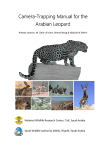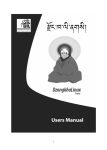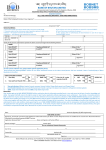Download national competency standards for automobile mechanic
Transcript
NATIONAL COMPETENCY STANDARDS FOR AUTOMOBILE MECHANIC Department of Occupational Standards Ministry of Labour and Human Resources Thimphu, Bhutan NATIONAL COMPETENCY STANDARDS FOR AUTOMOBILE MECHANIC Department of Occupational Standards Ministry of Labour and Human Resources Thimphu, Bhutan. First Revised Publication 2012 © Department of Occupational Standards (DOS), MoLHR. FOREWORD The Department of Occupational Standards of the Ministry of Labour and Human Resources proudly presents the revised version of the National Competency Standards (NCS) for Automobile Mechanic (Light Vehicle) as a major initiative for improving the quality of Vocational Education and Training System in Bhutan. These revised versions of the standards represent the fruits of hard work and invaluable experiences gained by the department since its establishment in the latter half of 2003. The main aim of developing National Competency Standards is to set up a well defined nationally recognized Vocational Qualification and Certification system that will help set a benchmark for the Vocational Education and Training (VET) System in our country aligned to international best practices. National Competency Standards is one of the base pillars in the Bhutan Vocational Qualification Framework (BVQF) and is the first step in its implementation. The standards are developed / revised to ensure that employees or vocational graduates possess and acquire the desired skills, knowledge and attitude required by industries and employers. In order to ensure this close match in supply and demand of skills, knowledge and attitude, standards have been developed in close consultation and partnership with industry experts and validated by the Technical Advisory Committees for the concerned economic sectors. A vocational education and training system based on National Competency Standards shall ensure that delivered training is of a high quality and relevant to the needs of the labour market. As a result, future VET graduates will be better equipped to meet the need and expectations of industries and employers. This positive impact on the employability of VET graduates will enhance the reputation of vocational education and training and make it attractive to school leavers. While acknowledging the existing level of cooperation and collaboration, the ministry earnestly requests employers and training providers to extend the fullest support and cooperation in implementing the National Competency Standards. The ultimate objective is to build a competent and productive national workforce that will contribute to the continued socio-economic progress of our country. I gratefully acknowledge the valuable contributions made by experts from industries during the consultation, verification and validation processes of the standards. I look forward to improved engagement and active participation of the industry and employers in the development of a quality assured demand driven VET system in the near future. I firmly believe we can sacrifice a bit today for a better tomorrow. Dorji Wangdi Minister Ministry of Labour and Human Resources INTRODUCTION A. National Competency Standards (NCS) National Competency Standards specify the skill, knowledge and attitudes applied to a particular occupation. Standards also specify the standards or criteria of performance of a competent worker and the various contexts in which work may take place. Standards provide explicit advice to assessors regarding the skill and knowledge to be demonstrated by candidates seeking formal recognition either following training or through work experience. Purpose of National Competency Standards Competency Standards serve a number of purposes including: Providing advice to curriculum developers about the skill and knowledge to be included in curriculum. Providing specifications to assessment resource developers about the skill, knowledge and attitudes within an occupation to be demonstrated by candidates. Providing advice to industry/employers about job functions, which in turn can be used for the development of job descriptions, performance appraisal systems and work flow analysis. B. Bhutan Vocational Qualification Framework (BVQF) Bhutan Vocational Qualifications Framework is an agreed system of Assessing, Certifying and Monitoring nationally recognized qualifications for all learning in the VET sector against national standards, in training institutions, in the workplace, in schools or anywhere where learning takes place. Components of the Bhutan Vocational Qualification Framework (BVQF) NATIONAL COMPETENCY STANDARDS COMPETENCY BASED CURRULUM ASSESSMENT RESOURCES TRAINING PROGRAMME COMPETENCY BASED ASSESSMENT CERTIFICATION CERTIFIED SKILLED WORKER INDUSTRY / LABOUR MARKET * RPL = Recognition of Prior Learning *RPL WORKERS FROM WORK PLACE BVQF Levels The Bhutan Vocational Qualification Framework has three levels classified based on the competency of the skilled workers. The three levels are: National Certificate Level 3 (NC III) National Certificate Level 2 (NC II) National Certificate Level 1 (NC I) - Master Craftsman Craftsman Semi Skilled Worker BVQF Level Descriptors The qualification levels are decided based on level descriptors. The detail of the qualification level descriptor is as follows: National Certificate Level 1 (Semi skilled) Carry out processes that: Learning demand: Responsibilities which are applied: Are narrow in range. Are established and familiar. Offer a clear choice of routine responses. Involve some prioritizing of tasks from known solutions. Basic operational knowledge and skill. Utilization of basic available information. Known solutions to familiar problems. Little generation of new ideas. In directed activity. Under general supervision and quality control. With some responsibility for quantity and quality. With no responsibility for guiding others. National Certificate Level 2 (Craftsman) Carry out processes that: Learning demand: Responsibilities which are applied: Require a range of well developed skills. Offer a significant choice of procedures requiring prioritisation. Are employed within a range of familiar context. Some relevant theoretical knowledge. Interpretation of available information. Discretion and judgement. A range of known responses to familiar problems In directed activity with some autonomy. Under general supervision and quality checking. With significant responsibility for the quantity and quality of output. With some possible responsibility for the output of others. National Certificate Level 3 (Master Craftsman) Carry out processes that: Learning demand: Responsibilities which are applied: Requires a wide range of tech-nical or scholastic skills. Offer a considerable choice of procedures requiring prioritization to achieve optimum outcomes. Are employed in a variety of familiar and unfamiliar contexts. A broad knowledge base which incorporates some theoretical concepts. Analytical interpretation of information. Informed judgement. A range of sometimes innovative responses to concrete but often unfamiliar problems. In self–directed activity. Under broad guidance and evaluation. With complete responsibility for quantity and quality of output. With possible responsibility for the output of others. PURPOSE This suite of three qualifications is designed for people interested in a career in the motor industry as an Auto Mechanic. The first of the qualifications is the National Certificate in Automobile Mechanic Level 1. It provides school leavers with generic and industry specific skills and demands a level of performance that will enable new recruits to the industry to be immediately productive. The qualification comprises four units of Competency Standards that cover the essential knowledge and skills required of auto mechanics in performing works related to servicing suspension system, steering system, brake system and clutch system of automobiles. The National Certificate in Automobile Mechanic Level 1 prepares people for entry into further qualifications in the motor industry and is a prerequisite for entry into the National Certificate Level 2. The National Certificate in Auto Mechanic Level 2 is the intermediate level qualification in this set. Candidates wishing to be admitted into training will already hold the National Certificate in Auto Mechanic Level 1. The Level 2 qualification recognizes the skills and knowledge required for people working as a skilled auto mechanic and builds on the skills and knowledge that candidates will have gained through the successful completion of the Level 1 certificate. The qualification includes five units of Competency Standards that cover knowledge and skills required in performing overhaul of power or drive train, servicing of engine auxiliary systems, performing spark ignition (SI) engine tune-up, performing diesel engine tune-up and performing basic auto electrical works. It is a prerequisite for entry into the Level 3 qualification. The National Certificate in Auto Mechanic Level 3 is currently the final achievement in this qualification pathway. Candidates wishing to be admitted into training will already hold the National Certificate in Auto Mechanic Level 2. The Level 3 qualification recognizes the competencies required to work as a highly skilled auto mechanic whose primary focus is the overall servicing and repair of motor vehicles. The only unit of Competency Standard included in the Level 3 National Certificate is the knowledge and skills required to perform overhaul of automotive engine. A diagram of the qualification pathway provided by these three National Certificates follows. PACKAGING OF QUALIFICATIONS FOR AUTOMOBILE MECHANIC The National Competency Standard for the Automobile Mechanic (L/V) comprises 10 units of competency standard, which are grouped to form three qualification levels, are shown below: National Certificate Level 3 Overhaul engine (7231-U10-L3) National Certificate Level 2 Perform basic auto electrical works (7231-U9-L2) Perform diesel engine tune-up (7231-U8-L2) Perform spark ignition (SI) engine tune-up (7231-U7-L2) Service engine auxiliary system (7231-U6-L2) Overhaul power or drive train (7231-U5-L2) National Certificate Level 1 Service clutch system (7231-U4-L1) Service brake system (7231-U3-L1) Service steering system (7231-U2-L1) Service suspension system (7231-U1-L1) ENTRY CODING USED FOR NATIONAL COMPETENCY STANDARDS The coding and classification system developed in Bhutan is logical, easy to use, and also aligned with international best practises. The Bhutanese coding and classification system is based on the International Standard Classification of Occupations, 2008 (ISCO-08) developed by the International Labour Organisation (ILO). The coding of the national competency standards forms the basis of the identification code for the Vocational Education and Training Management Information System (VET – MIS) both in terms of economic sector identification and that of the individual standard. Coding the individual units of competency standard is to identify the level in qualification packages to which it belongs. While packaging, in order to follow a logical order, only competency standards related to each other and following a logical sequence in terms of training delivery, from the simple to the complex, are clustered into a qualification packages. The ILO assigns the code 7231 to the occupation of Auto mechanic and related trades. Therefore, in the Bhutan context, the occupation Auto Mechanic has been assigned the code 7231 in the National Coding System. The first unit is assigned the code U1, the first Unit of Competency Standard clustered into the first qualification is designated the code 7231-U1. Levels are assigned the code L and follow a logical progression from the National Certificate Level 1 (NC I) to the National Certificate Level 3 (NC III). Therefore the National Certificate Level 1 is assigned the code L1. The complete unit code will be 7231-U1-L1. Key: MoLHR – Ministry of Labour and Human Resources DHR – Department of Human Resources DOS – Department of Occupational Standards NATIONAL COMPETENCY STANDARDS FOR AUTO MECHANIC rd Validation date : 23 November 2012. Endorsement date : 4 December 2012. Date of Review : 4 December 2015 (Max. 3 years). th th Technical Advisory Committee (TAC) members for the Automobile Sector involved in the validation of NCS: 1. Bhim Raj Gurung (TAC Chairman), Manager, Kancha Automobile Workshop, Thimphu. 2. Dawa Drukpa, Manager, Tashi Engineering Workshop, Phuentsholing. 3. Sangay Wangchuk, Principal, Technical Training Institute, Samthang. 4. Gyem Dorji, Head of Department, Technical Training Institute, Thimphu. 5. Lhatu Dorji, Proprietor, L. D Engineering Workshop, Phuentsholing. 6. Tshewang Lham, Manager, Zimdra Automobiles, Phuentsholing. 7. Lhundup Dorji, Asst. RTO, Road Safety and Transport Authority, Thimphu. 8. Karma Dorji, Senior Programme Officer, Training and Professional Services Division, Department of Human Resources, MoLHR, Thimphu. 9. Karma Loday (TAC Member Secretary), Chief Programme Officer, Standards and Qualification Division, Department of Occupational Standards, MoLHR, Thimphu. Subject experts (auto mechanic) involved during the revision workshop of Auto Mechanic NCS: 1. Dawa Dakpa, Tashi Engineering Workshop, Phuentsholing. 2. Ugyen Dorji, Technical Training Institute, Samthang. 3. Sonam Tobgay, Technical Training Institute, Thimphu. 4. Nima Tshering, State Trading Corporation of Bhutan Limited, Phuentsholing. 5. Deepak Gurung, Gangkhap Engineering Workshop, Phuentsholing. 6. Bhim Kumar Pokwal, Zimdra Automobiles, Phuentsholing. 7. Nirmal Sariba, Wangdi Engineering Workshop, Phuentsholing. 8. Tapas Sarkar, Druk Penden Engineering Workshop, Phuentsholing. 1. Tshewang, Senior Programme Officer (Facilitator), Department of Occupational Standards (DOS), MoLHR, Thimphu. TABLE OF CONTENTS – COMPETENCY STANDARDS FOR AUTOMOBILE MECHANIC NATIONAL CERTIFICATE – LEVEL 1 UNIT TITLE ELEMENTS OF COMPETENCE Service suspension system 1. Diagnose suspension system failures. Service steering system 1. Perform wheel alignment. 2. Replace faulty suspension components. 2. Service steering system. PAGE 19 21 3. Perform wheel balancing 4. Analyze kingpin condition Service brake system 1. Diagnose faults in brake system. 2. Overhaul and service or repair brake system components. 24 3. Adjust brake system. Service clutch system 1. Diagnose clutch failures. 2. Overhaul and service clutch mechanism. 3. Adjust clutch system. 34 NATIONAL CERTIFICATE – LEVEL 2 UNIT TITLE Overhaul power or drive train ELEMENTS OF COMPETENCE PAGE 1. Diagnose transmission failure. 2. Replace or repair components of transmission. 3. Test transmission. 4. Repair and replace components of propeller shaft. 36 5. Repair or replace components of final drive and differential. 6. Repair or replace wheel bearings and components. 7. Replace components of drive or axle shaft. Service engine auxiliary system 1. Service cooling system 2. Service lubricating system. 3. Service petrol fuel system. 31 4. Service diesel fuel system. Perform spark ignition (SI) engine tune-up 1. Check fuel system. 2. Check and test ignition system. 3. Check and adjust drive belt. 4. Check engine compression. 44 5. Check and adjust engine speed. 6. Check valve tappet clearance. Perform diesel engine tune-up 1. Check fuel injection system. 2. Check drive belt. 3. Check engine compression. 4. Check valve tappet clearance. 47 Perform basic auto electrical works 1. Inspect and replace basic electrical components. 2. Test automotive battery. 41 3. Service and charge batteries. 4. Jump start vehicle. NATIONAL CERTIFICATE – LEVEL 3 UNIT TITLE Overhaul engine ELEMENTS OF COMPETENCE PAGE 1. Diagnose problems and dismount engine. 2. Dismantle engine. 3. Perform engine component analysis. 4. Assemble engine. 5. Test engine. 49 AUTOMOBILE MECHANIC COMPETENCY STANDARDS FOR NATIONAL CERTIFICATE LEVEL 1 (NC I) UNIT TITLE ELEMENTS OF COMPETENCE Service suspension system 1. Diagnose suspension system failures. Service steering system 1. Perform wheel alignment. 2. Replace faulty suspension components. 2. Service steering system. 3. Perform wheel balancing 4. Analyze kingpin condition Service brake system 1. Diagnose faults in brake system. 2. Overhaul and service or repair brake system components. 3. Adjust brake system. Service clutch system 1. Diagnose clutch failures. 2. Overhaul and service clutch mechanism. 3. Adjust clutch system. UNIT TITLE Service suspension system. DESCRIPTOR This unit covers the competencies required to inspect and replace the components of the suspension system. CODE 7231- U1- L1 ELEMENTS OF COMPETENCE 1. Diagnose suspension system failures. 2. Replace faulty suspension components. PERFORMANCE CRITERIA 1.1 Identify symptoms that indicate suspension failure. 1.2 Identify the fault and recommend repair action in accordance with standard practices. 1.3 Provide support to the vehicle to avoid personal injury or damage to the vehicle as per the job requirements 1.4 Check suspension components for defects using tools and equipment and industry accepted techniques. 2.1 Dismount and mount suspension components as per service manual. 2.2 Dismount components without damage to other vehicle parts. 2.3 Disassemble and assemble suspension components without causing damage to other parts. 2.4 Service the disassembled components as per the job requirements. 2.5 Replace damaged parts as specified in service manual RANGE STATEMENT Tools and equipment May include but not limited to: Industry accepted techniques Include but not limited to: Suspension components Includes: Service May include but not limited to: Lift, support stand, grease dispenser, coil spring compressor, heavy duty socket wrench, basic hand tools, hydraulic press, torque wrench, hydraulic jack, shock absorber testing equipment, puller. Drive test, visual inspection, audio test, diagnostic equipment. Stabilizer bar and linkages, coil and leaf springs, torsion bar, shock absorbers, suspension arms and bushes, ball joints, control arms. Replace, Cleaning, Greasing ASSESSMENT GUIDE Form of assessment Continuous assessment together with collected evidence of performance will be used. Evidence of the performance shall be based on practical demonstration. Knowledge can be assessed through diagrams, in writing or orally (viva-voce). Assessment context Competency may be assessed in the actual work place or in a simulated workplace setting. Assessment condition The candidate shall have access to all required tools, equipment, materials and documents. The candidate must complete the assessment in industry accepted time frame. Critical aspects Demonstrate compliance with safety regulation applicable to work site operation. Identify defects and problems that occur and take necessary action to rectify (uncomfortable or bumpy driving, noise when moving or stopped, poor directional stability, shimming of the front wheel while steering at high speed, pulling to one side while driving or braking, irregular tyre wear) in accordance with standard practices. UNDERPINNING KNOWLEDGE UNDERPINNING SKILLS Operating principles of suspension system. Use of tools and equipment. Cleaning suspension parts. Types of suspension systems. Personal protective equipment. Replacing suspension components. Sealant and adhesives Use of sealant and adhesives Types of cleaning solvent UNIT TITLE Service steering system. DESCRIPTOR This unit covers the competencies required to service or overhaul a steering system, and perform wheel alignment and wheel balancing. CODE 7231-U2-L1 ELEMENTS OF COMPETENCE 1. Perform wheel alignment 2. Service steering system. 3. Perform wheel balancing. PERFORMANCE CRITERIA 1.1 Perform visual inspections of tyre conditions and inflation. 1.2 Check steering linkages in accordance with standard practices 1.3 Set up wheel alignment using equipment according to the manufacturer’s specification. 1.4 Inspect and make necessary adjustments to steering geometry according to the manufacturer’s specification. 2.1 Check steering system for wear and tear in accordance with standard practices. 2.2 Remove steering system components as per standard procedures. 2.3 Dismantle and replace defective steering components as per the standard practices. 2.4 Assemble and install the steering components as per standard procedures. 2.5 Use personal protective equipment (PPE) as per the job requirements. 3.1 Mount the wheel on wheel balancing machine as per standard procedures. 3.2 Identify balance weight location following standard practices. 3.3 Adjust and balance the wheel as indicated by the wheel balancing machine. 4. Analyze kingpin condition. 4.1 Identify defective kingpin parts and recommend corrective action as per the job requirements. 4.2 Dismantle kingpin as per service manuals. 4.3 Inspect and service kingpin parts as per service manuals. 4.4 Participate in test drive to ensure proper functioning. RANGE STATEMENT Equipment May include but not limited to: Lift, support stand, heavy duty socket wrench, torque wrench, basic hand tools, caster-camber gauge, puller, wheel alignment equipment, wheel balancing machine. Steering geometry Includes but not limited to: Positive and negative camber, toe-in and toe-out, kingpin inclination. Steering system May include but not limited to: Re-circulating ball bearing type; worm and gear; rack and pinion; power assisted steering (hydraulic, electrical); steering linkages. Wear and tear May include but not limited to: Cracks, loose or broken parts, worn out. Standard procedures / practices May include: Personal protective equipment (PPE) Includes: Job card, requisition slip, gate pass. Apron, gloves, safety shoes, workshop dress. Service May include but not limited to: Replacement, adjustment, cleaning, greasing ASSESSMENT GUIDE Form of assessment Continuous assessment together with collected evidence of performance will be used. Evidence of the performance shall be based on practical demonstration. Knowledge can be assessed through diagrams, in writing or orally (viva-voce). Assessment context Competency may be assessed in the actual work place or in a simulated workplace setting. Assessment condition The candidate shall have access to all required tools, equipment, materials and documents. The candidate must complete the assessment in industry accepted time frame. Critical aspects Demonstrate compliance with safety regulation applicable to work site operation. Identify defects and problems that occur and take necessary action to rectify (Shoulder wear, centre wear, feather wear, manufacturing defects, uneven wearing) in accordance with standard practices. UNDERPINNING KNOWLEDGE UNDERPINNING SKILLS Operating principles of steering system. Accessing, interpreting and applying technical information. Types of steering systems. Safe handling of equipment and Manufacturer specifications. Occupational Health and Safety (OHS) Regulations. Causes of defects in steering system. Sealant and adhesives Types of solvent tools. Use of sealant and adhesives Applying personal safety procedures. Interpersonal and communication. Team work. UNIT TITLE Service brake system. DESCRIPTOR This unit covers the competencies required to diagnose, adjust, repair, and service a brake system. CODE 7231-U3-L1 ELEMENTS OF COMPETENCE PERFORMANCE CRITERIA 1. Diagnose faults in brake system. 1.1 Participate in road test to detect faulty brake system for different types of brake systems. 1.2 Diagnose faults and recommend remedial action. 2. Overhaul and service brake system components. 2.1 Remove and mount brake system components as per service manual. 2.2 Clean parts with solvent and materials as per job requirements. 2.3 Inspect parts for wear and tear of the components and take necessary action. 2.4 Assemble the brake system components as per the service manual. 2.5 Inspect condition and level of brake fluid and replace if necessary as per the specifications. 3.1 Bleed the brake system in accordance with service manual. 3.2 Check the brake system components for proper functioning. 3.3 Adjust the brake including the parking brake as required in accordance with service manual. 3.4 Adjust the brake pedal free play in accordance with service manual. 3.5 Participate in road test to ensure brake system is functioning properly 3. Adjust brake system. RANGE STATEMENT Brake system Includes: Different types of brakes – service brake, parking brake, auxiliary brake. Different brake systems – drum brakes, disc brakes, and antilock braking system (ABS) Different brake operation – pneumatic, hydraulic, mechanical. Brake system components May include but not limited to: Materials Include: Master cylinder (tandem and conventional), , drum, brake pad, brake disc, brake shoe, brake calliper, brake hoses, tubes, wheel cylinder kit, wheel cylinder, springs, bleeding nipples, brake booster. Brake fluid, lithium grease, water paper, emery cloth Brake fluid May include but is not limited to: DOT 3, DOT 4, DOT 5, DOT 5.1. ASSESSMENT GUIDE Form of assessment Continuous assessment together with collected evidence of performance will be used. Evidence of the performance shall be based on practical demonstration. Knowledge can be assessed through diagrams, in writing or orally (viva-voce). Assessment context Competency may be assessed in the actual work place or in a simulated workplace setting. Assessment condition The candidate shall have access to all required tools, equipment, materials and documents. The candidate must complete the assessment in industry accepted time frame. Critical aspects Demonstrate compliance with safety regulation applicable to work site operation. Identify defects and problems that occur and take necessary action to rectify. Bleeding and adjustment of brake in accordance with service manual. UNDERPINNING KNOWLEDGE Basic operating principles of brake systems. Types of brake systems. UNDERPINNING SKILLS Use of tools and equipment. Applying personal safety work practice. Occupational Health and Safety (OHS) Regulations. Maintaining orderliness and cleanliness. Manufacturer specifications. Range of brake fluids. Interpersonal and communication. Types of solvent Ability to work in a team. Pascal’s law UNIT TITLE Service clutch system. DESCRIPTOR This unit covers the competencies required to maintain and replace damaged components of the clutch system CODE 7231-U4-L2 ELEMENTS OF COMPETENCE 1. Overhaul and service clutch mechanism. 2. Adjust clutch system PERFORMANCE CRITERIA 1.1 Indentify and diagnose clutch related failures and recommend rectification procedures. 1.2 Dismount and mount clutch assembly as per service manual. 1.3 Dismantle clutch system components without causing damage to the parts or to the vehicle. 1.4 Overhaul hydraulic clutch mechanism as per service manual 1.5 Check the components of the clutch mechanism and replace faulty components as per standard procedures. 1.6 Check clutch fluid conditions and level, check for any leakage, and rectify if necessary as per standard procedures. 2.1 Adjust clutch in accordance with the service manual. 2.2 Bleed clutch system in accordance with standard procedures. RANGE STATEMENT Clutch system components Includes but not limited to: Clutch cover assembly, clutch disc, clutch linkage, clutch release bearing, pilot bearing, clutch release fork, release spring, release fork adjuster, clutch master cylinder, slave cylinder, release cylinder kits, clutch cables ASSESSMENT GUIDE Form of assessment Continuous assessment together with collected evidence of performance will be used. Evidence of the performance shall be based on practical demonstration. Knowledge can be assessed through diagrams, in writing or orally (viva-voce). Assessment context Competency may be assessed in the actual work place or in a simulated workplace setting. Assessment condition The candidate shall have access to all required tools, equipment, materials and documents. The candidate must complete the assessment in industry accepted time frame. Critical aspects Demonstrate compliance with safety regulations applicable to work site operations. Troubleshoot and service clutch system in accordance standard procedures Bleed / adjust clutch system in accordance with standard procedures. UNDERPINNING KNOWLEDGE UNDERPINNING SKILLS Types, function, and operation of clutch components. Interpreting and applying technical information. Clutch system adjustment. Hydraulic clutch mechanism, function and operation. Using relevant tools and equipment. Adjusting clutch components. Handling hydraulic fluids. Occupational Health and Safety Applying personal safety procedures. (OHS) Regulations. Ability to work in a team. Cause, symptoms and diagnose of clutch system failures. Interpersonal and communication Types of solvents Types of clutch plate materials Pascal’s law AUTOMOBILE MECHANIC COMPETENCY STANDARDS FOR NATIONAL CERTIFICATE LEVEL 2 (NC II) UNIT TITLE Overhaul power or drive train ELEMENTS OF COMPETENCE 1. Diagnose transmission failure. 2. Replace or repair components of transmission. 3. Test transmission. 4. Repair and replace components of propeller shaft. 5. Repair or replace components of final drive and differential. 6. Repair or replace wheel bearings and components. 7. Replace components of drive or axle shaft. Service engine auxiliary system 1. Service cooling system 2. Service lubricating system. 3. Service petrol fuel system. 4. Service diesel fuel system. Perform spark ignition (SI) engine tune-up 1. Check fuel system. 2. Check and test ignition system. 3. Check and adjust drive belt. 4. Check engine compression. 5. Check and adjust engine speed. 6. Check valve tappet clearance. Perform diesel engine tune-up 1. Check fuel injection system. 2. Check drive belt. 3. Check engine compression. 4. Check valve tappet clearance. Perform basic auto electrical works 1. Inspect and replace basic electrical components. 2. Test automotive battery. 3. Service and charge batteries. 4. Jump start vehicle. UNIT TITLE Overhaul power or drive train. DESCRIPTOR This unit covers the competencies required to diagnose, overhaul and test automatic and manual transmissions, front and rear axles, and propeller shafts. CODE 7231-U5-L2 ELEMENTS OF COMPETENCE PERFORMANCE CRITERIA 1. Diagnose transmission failure 1.1 Identify transmission failure symptoms in accordance standard procedures. 1.2 Inspect the condition of the Automatic Transmission Fluid (ATF), where applicable following standard procedures. 2. Service transmission components 2.1 Drain transmission oil in accordance with standard procedures. 2.2 Disassemble and assemble transmission as per standard procedures and tag disassembled parts. 2.3 Inspect transmission for worn-out and damaged parts, and measure backlash following standard procedures. 2.4 Service component parts in accordance with service manual. 2.5 Install transmission as per service manual. 2.6 Participate in road test following standard procedures 3.1 Diagnose propeller shaft problems following standard procedures. 3.2 Dismount propeller shaft as per service manual. 3.3 Dismantle or assemble propeller shaft components in accordance with standard 3. Service propeller shaft components procedures. 4. Service final drive and differential components. 5. Service wheel bearings and components 3.4 Inspect and service faulty parts and replace if necessary in accordance with standard procedures. 3.5 Participate in test drive following standard procedures 4.1 Identify final drive and differential problems following standard procedures. 4.2 Change differential oil in accordance with service manual. 4.3 Dismount the differential as per service manual. 4.4 Identify and analyze defective parts and recommend necessary remedial action. 4.5 Measure backlash, check correct gear mesh of final drive, and interpret findings. 4.6 Dismantle differential parts as per service manual and tag the dismantled parts. 4.7 Assemble and adjust parts as per service manual and specifications using special service tools (SST). 4.8 Participate in test drive following standard procedures 5.1 Diagnose wheel bearing problems following standard procedures. 5.2 Disassemble wheel hub and bearing as per service manual using special service tools. 5.3 Identify and analyze defective parts and recommend necessary remedial actions. 5.4 Assemble and adjust as per service manual and specifications. 5.5 Measure preload and adjust in accordance with service manual. 5.6 Participate in test drive following standard procedures. 6. Service drive or axle shaft components 6.1 Diagnose drive or axle shaft following standard procedures. 6.2 Dismantle drive or axle shaft as per service manual and tag the dismantled parts. 6.3 Identify and analyze the defective parts and recommend remedial actions. 6.4 Service defective parts following standard procedures. 6.5 Assemble as per service manual. 6.6 Participate in test drive following standard procedures. RANGE STATEMENT Power train or drive train Includes but not limited to: Transmission Includes: Transmission, drive shaft, CV joint, propeller shaft, centre bearing, cross bearing, spider kit, axle, differential, transaxle, final drive. Automatic and manual; four (4) speed, five (5) speed, and six (6) speed transmissions; transaxle transmission. Tools and equipment Includes: Lift/support stand, transmission jack, snap ring expander (in/out), bearing puller, drift punch, basic hand tools set, bench vice, special service tools (SST), dial gauge, grease gun, oil gun, axle puller, hydraulic press, torque wrench, pre-load gauge. ASSESSMENT GUIDE Form of assessment Continuous assessment together with collected evidence of performance will be used. Evidence of the performance shall be based on practical demonstration. Knowledge can be assessed through diagrams, in writing or orally (viva-voce). Assessment context Competency may be assessed in the actual work place or in a simulated workplace setting. Assessment condition The candidate shall have access to all required tools, equipment, materials and documents. The candidate must complete the assessment in industry accepted time frame. Critical aspects Demonstrate compliance with safety regulations applicable to work site operations. Troubleshoot transmission, drive shafts, differential, final drive and then servicing following standard procedures. Adjustment of gears following standard procedures. UNDERPINNING KNOWLEDGE UNDERPINNING SKILLS Problems and causes in power or drive train. Reading, interpreting, and applying service manuals. Overhaul or repair procedures of power or drive train. Use of proper tools and equipment. Use of different types of lubricants or fluids. Checking power or drive train for normal operation drive. Operating principles of power train or drive train. Applying personal safety procedures. Equipment safety requirements. Personal safety procedures. Applying sealant and adhesives. Sealant and adhesives Ability to work in a team. Types of solvent Difference between differential and final drive Gear ratio UNIT TITLE Service engine auxiliary system. DESCRIPTOR This unit covers the competencies required to service the cooling, lubricating, and fuel systems in petrol and diesel engines. CODE 7231- U6-L2 ELEMENTS OF COMPETENCE 1. Service cooling system. 2. Service lubricating system. 3. Service petrol fuel system. PERFORMANCE CRITERIA 1.1 Diagnose faulty components of cooling system in accordance with standard practices. 1.2 Service cooling system components as per the service manual. 1.3 Replace faulty parts and coolant as per the manufacturer’s specifications. 1.4 Change and adjust the fan belt tension to the specified tension as per the service manual 1.5 Check and rectify the stray current in accordance with standard operating procedures 2.1 Check pressure, level, and condition of engine oil as per owner’s manual. 2.2 Perform oil flushing, if necessary as per service manual instructions. 2.3 Change engine oil and filter following standard procedures. 2.4 Service lubricating system components as per the service manual 2.5 Run the engine and check for leakage following standard procedures 3.1 Inspect fuel filter for clogging and replace if necessary following standard procedures. 3.2 Inspect fuel pipes for leakage or damage and replace if necessary following standard procedures. 4. Service diesel fuel system. 3.3 Service or repair carburettor according to manufacturer’s service manual. 3.4 Inspect and service injectors and replace if necessary following standard procedures. 3.5 Inspect and repair fuel pump according to service manual. 3.6 Inspect exhaust gas emission and perform adjustment in accordance with set standard. 4.1 Inspect fuel filter for clogging and replace if necessary following standard procedures. 4.2 Inspect fuel pipes for leakage and damage and replace if necessary following standard procedures. 4.3 Participate in servicing or replacing pump components as per the job requirements. 4.4 Inspect, service or replace, and adjust fuel injector and components according to service manual. 4.5 Inspect exhaust gas emission and perform necessary adjustment in accordance to set standard. RANGE STATEMENT Cooling system components May include but not limited to: Lubricating system components May include but not limited to: Petrol fuel system components May include but not limited to: Coolant, radiator, thermostat, fan, radiator cap, water pump, hoses, fan belt, temperature gauge or sensors. Sensors, engine flushing oil, engine oil (as per specifications), engine oil filter. Sensors, filter, pumps, tubes, injectors, common rail distribution injection (CRDI). Diesel fuel system components May include but not limited to: Sensors, filter, pumps, tubes, injectors, common rail distribution injection (CRDI). ASSESSMENT GUIDE Form of assessment Continuous assessment together with collected evidence of performance will be used. Evidence of the performance shall be based on practical demonstration. Knowledge can be assessed through diagrams, in writing or orally (viva-voce). Assessment context Competency may be assessed in the actual work place or in a simulated workplace setting. Assessment condition The candidate shall have access to all required tools, equipment, materials and documents. The candidate must complete the assessment in industry accepted time frame. Critical aspects Demonstrate compliance with safety regulations applicable to work site operations. Troubleshoot and service engine auxiliary system in accordance with service manual. UNDERPINNING KNOWLEDGE Principle and operation of cooling system. UNDERPINNING SKILLS Using and interpreting service manuals. Principle and operation of lubricating system. Type of fuel, oil and their specifications. Fuel system basic principle and operation. Quality of engine oil, coolant and characteristics. Occupational Health and Safety (OHS) Regulations. Function of Positive Crankcase Ventilation (PCV). Types of solvent Sealant and adhesives UNIT TITLE Diagnosing engine faults. Applying personal safety procedures. Applying sealant and adhesives Interpersonal and communication. Ability to work in a team. Perform spark ignition (SI) engine tune-up. DESCRIPTOR This unit covers competencies required to carry out spark ignition (SI) engine maintenance to the vehicle at optimum engine performance. CODE 7231-U7-L2 ELEMENTS OF COMPETENCE 1. Service air / fuel system. PERFORMANCE CRITERIA 1.1 Check fuel pump for pressure and leakage using pulsation damper for Electronic Fuel injection (EFI) system, and carburettor system following standard procedures. 1.2 Service fuel system components following standard procedures. 1.3 Service air system components following standard procedures 1.4 Service exhaust system components following standard procedures 2.1 Inspect distributor and CB point for wear, service or replace as necessary. 2.2 Test HT cable and ignition coil for required resistance. 2.3 Service ignition system components following standard procedures. 3. Check and adjust drive belt. 3.1 Check drive belt for defects or tension following standard procedures. 3.2 Adjust drive belt tension to specified tension and replace if worn out following standard procedures. 4. Check engine compression. 4.1 Conduct compression test using compression gauge. 4.2 Interpret compression test result and take necessary actions in accordance with standard procedures. 2. Check and test ignition system. 5. Check and adjust engine speed. 5.1 Check idle speed following standard procedures. 5.2 Adjust idle speed (rpm) following standard procedures 6. Check valve tappet clearance 6.1 Check valve tappet clearance as per service manual. 6.2 Set valve tappet clearance as per the service manual. RANGE STATEMENT Fuel system components Includes but not limited to: Air system components Includes but not limited to: Ignition system components May include but not limited to: Exhaust system components May include but not limited to: Fuel injection pumps (FIP), electrical pump, mechanical pump, fuel injector, fuel filter, feed pump and carburettor. Air filter, ail filter case, air flow sensors. Distributor, ignition coil, HT cable, spark plug, transistorized ignition system. Exhaust manifold, turbo charger, exhaust pipe, catalytic converter, silencer box. ASSESSMENT GUIDE Form of assessment Continuous assessment together with collected evidence of performance will be used. Evidence of the performance shall be based on practical demonstration. Knowledge can be assessed through diagrams, in writing or orally (viva-voce). Assessment context Competency may be assessed in the actual work place or in a simulated workplace setting. Assessment condition The candidate shall have access to all required tools, equipment, materials and documents. The candidate must complete the assessment in industry accepted time frame. Critical aspects Demonstrate compliance with safety regulations applicable to work site operations. Perform spark ignition (SI) engine tune up following standard procedures. UNDERPINNING KNOWLEDGE Process of engine tune up. Basic auto electrical and electronics Types of lubricants and fluids. Equipment safety requirements. Personal safety requirements. UNDERPINNING SKILLS Reading, interpreting and applying service manual instruction. Using tools and equipment safely. Applying maintenance procedures. Exhaust systems Communication. Service manual. Ability to work in a team. Cleaning methods and materials. Principle of engine operation UNIT TITLE Perform diesel engine tune-up. DESCRIPTOR This unit covers competencies required to perform diesel engine maintenance in order to keep the vehicle in good running condition and optimum engine performance, and to prevent serious engine trouble. CODE 7231-U8-L2 ELEMENTS OF COMPETENCE 1. Service fuel injection system. 2. Service drive belt. 3. Check engine compression. 4. Check valve tappet clearance. PERFORMANCE CRITERIA 1.1 Check fuel injection system following standard procedures 1.2 Service fuel injection system following standard procedures 1.3 Set injection timing in accordance with service manuals. 2.1 Check drive belt for tension and wear following standard procedures. 2.2 Adjust drive belt tension to specified tension and replace if worn out following standard procedures. 3.1 Conduct compression test following standard procedures. 3.2 Interpret compression test result and carry out necessary action following standard procedures. 4.1 Check valve tappet clearance as per service manual. 4.2 Set valve tappet clearance as per the service manual. RANGE STATEMENT Fuel injection system Includes but not limited to: Common Rail Direct Injection (CRDI) system, Fuel Injection Pump (FIP) system, fuel filter, air cleaner, injectors, fuel feed pump. ASSESSMENT GUIDE Form of assessment Continuous assessment together with collected evidence of performance will be used. Evidence of the performance shall be based on practical demonstration. Knowledge can be assessed through diagrams, in writing or orally (viva-voce). Assessment context Competency may be assessed in the actual work place or in a simulated workplace setting. Assessment condition The candidate shall have access to all required tools, equipment, materials and documents. The candidate must complete the assessment in industry accepted time frame. Critical aspects Demonstrate compliance with safety regulations applicable to work site operations. Perform diesel engine tune up following standard procedures. UNDERPINNING KNOWLEDGE Types of fuel injection system. Basic electrical and electronics UNDERPINNING SKILLS Safe use of tools and equipment. Applying maintenance Procedure of engine tune up. Types of lubricants and fluids. Communication. Equipment safety requirements. Ability to work in a team. Personal safety requirements. Cleaning methods and materials. Principle of engine operation. Interpretation of manual and specification. procedures. UNIT TITLE Perform basic auto electrical works. DESCRIPTOR This unit covers competencies required to carry out basic auto electrical work. CODE 7231-U9-L2 ELEMENTS OF COMPETENCE PERFORMANCE CRITERIA 1. Inspect and replace basic electrical components. 1.1 Inspect and service basic auto electrical components for defects following standard procedures. 1.2 Service defective parts in accordance with manufacturer’s specifications. 2. Service batteries and jump start vehicles. 2.1 Take precautions to prevent loss or damage of electrical components. 2.2 Test battery conditions following standard procedures. 2.3 Analyze results and recommend remedial action in accordance with standard procedures. 2.4 Jump start vehicle following standard procedures RANGE STATEMENT Basic auto electrical components Includes but not limited to: Tests Include: Fusible linkages, starter motor, alternators, horn, lighting equipment, wires, wipers. Open circuit test, short circuit test, load test, specific gravity test, cell voltage test. Tools and equipment Includes: Multimeter and test lamps, load tester, hydrometer, battery charger, cell tester. ASSESSMENT GUIDE Form of assessment Continuous assessment performance will be used. Evidence of the demonstration. Knowledge can be assessed through diagrams, in writing or orally (viva-voce). together performance with shall collected be based evidence on of practical Assessment context Competency may be assessed in the actual work place or in a simulated workplace setting. Assessment condition The candidate shall have access to all required tools, equipment, materials and documents. The candidate must complete the assessment in industry accepted time frame. Critical aspects Demonstrate compliance with safety regulations applicable to work site operations Service basic procedures. auto electrical components UNDERPINNING KNOWLEDGE Occupational Health and Safety (OHS) Regulations. Procedures of installing electrical devices. Operation of electrical system and components relevant to application. Electrical principles and their application to wiring/lighting. National Environment Commission Act and regulations in relation to the disposal of batteries and acids. Safe handling of battery electrolyte. Identification of battery types. Servicing and jump start procedures. Battery charging procedures. following standard UNDERPINNING SKILLS Identifying wire gauge or sizes. Operating basic auto electrical system. Testing and fault finding. Reading and interpretation of diagrams and circuits. Handling battery. Use of multimeter, hydrometer, load tester, voltmeter, ammeter, cell tester. Use of hand tools. Preventing loss of vehicle electronic memory. AUTOMOBILE MECHANIC COMPETENCY STANDARDS FOR NATIONAL CERTIFICATE LEVEL 3 (NC III) UNIT TITLE Overhaul engine ELEMENTS OF COMPETENCE 1. Diagnose problems and dismount engine. 2. Dismantle engine. 3. Perform engine component analysis. 4. Assemble engine. 5. Test engine. UNIT TITLE Overhaul engine. DESCRIPTOR This unit covers competencies required to carry out engine overhaul and related maintenance. CODE 7231-U10-L3 ELEMENTS OF COMPETENCE 1. Diagnose problems and dismount engine 2. Service engine. PERFORMANCE CRITERIA 1.1 Troubleshoot engine problems following standard procedures 1.2 Tag removable connections using specific codes following standard procedures 1.3 Dismount engine and components as per service manual. 2.1 Dismantle engine in accordance with the service manual. 2.2 Service engine components with recommended solvents following standard procedures 2.3 Recommend repair, rectification or any necessary machining jobs following standard procedures 2.4 Assemble the engine components and aggregates as per the service manual. 2.5 Tests run the engine following standard procedures. 2.6 Participate in road test following standard procedures. RANGE STATEMENT Removable connections Includes but not limited to: Wires and cables, hoses, tubing and controls. Engine components Includes but not limited to: Engine block, piston, connecting rods, main bearings, connecting bearing, crank shaft, oil pump, oil pressure, relieve valves, exhaust or intake valves, cylinder liner, cylinder head, combustion chambers, valve guide, valve seats, valve lifter, valve shims, rocker arms, rocker shims, springs, oil nozzle. ASSESSMENT GUIDE Form of assessment Continuous assessment together with collected evidence of performance will be used. Evidence of the performance shall be based on practical demonstration. Knowledge can be assessed through diagrams, in writing or orally (viva-voce). Assessment context Competency may be assessed in the actual work place or in a simulated workplace setting. Assessment condition The candidate shall have access to all required tools, equipment, materials and documents. The candidate must complete the assessment in industry accepted time frame. Critical aspects Demonstrate compliance with safety regulations applicable to work site operations. Service and testing of engine following standard procedures UNDERPINNING KNOWLEDGE Occupational Health and Safety UNDERPINNING SKILLS Reading, interpreting, and (OHS) Regulations. applying service manual instruction. Procedures of overhauling engine. Operating principle of engine and its components. Safe use of tools and equipment. Use of consumable items. Applying maintenance procedures. Communication. Ability to work in a team. National Environment Commission Act and regulations in relation to the disposal of hazardous waste materials. Safe Handling of engine components. Identification of types of engine. Measuring instruments and equipment. Interpretation of manual and specifications


























































